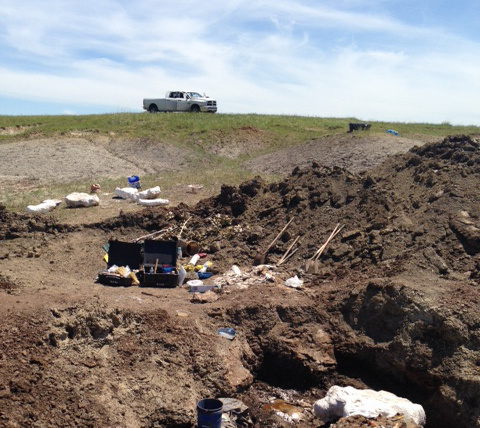Triceratops Dig 2014 Recap

Our time at the Triceratops site came to an end on Friday, June 27. As we rushed to get the last jackets out of the quarry and close down the site for the year, a menacing storm was rolling in, but we made it out just in time (Figure 1). With the back of our pick-up truck filled with plaster jackets (Figure 2), we headed back to the Royal Ontario Museum.

Even though we had rain and water troubles during our dig, we were able to get a lot accomplished over the short 2-week field season. We mapped 64 bones (!), and were able to collect most of these during our field time. The quarry map shows just how jumbled up the bones of our Triceratops were - the jaw is on top of a rib, the shoulder blade lies on top of vertebrae, and the pelvic bones (the ischium) are separated at one end of the quarry (Figure 3).

The bones we uncovered and collected represent only about 20% of an entire skeleton, but they are from all parts of the body (Figure 4). We found parts of the skull, shoulder girdle, pelvis, and vertebrae from the back and tail, as well as a lot of ribs. We expect to find lots of ribs and vertebrae, because they are the most common bones in the body, so we were quite happy to find the jaw and frill bones (and the nose horn!).

We were not able to collect all of the bones we uncovered, so we put a tarp of the bones we didn’t have time to get out of the ground, and buried them (for protection over the winter). We hope to come back next year to year and continue the dig - we know there are even more bones on this site that we have not uncovered yet. There is a lot of work to do next season, and with any luck, we will find more bones of the Triceratops skeleton.

Once back at the Museum (Figure 5), the next step is to open the plaster jackets and carefully clean the fossils bones. This process, called preparation, is a very detailed and time-consuming process. Since I wanted to get an idea of the quality of the bones we collected, I selected a couple of the jackets to open and prepare. Shino Sugimoto has already worked on the lower jaw, and it turned out spectacular (Figure 6); it even had a few teeth preserved in place. But the big surprise turned up in the other block, currently being prepared by Ian McDonald: hiding in one of the large concretions (a hard, compact mass of sedimentary rock) we collect was the prize of the dig so far - an almost complete nose horn (Figure 7). This is particularly important because it allows us to identify the precise species of Triceratops. In our case, the long nose horn tells that we have a Triceratops prorsus, the last species of Triceratops. The find also helps confirm new work that shows T. prorsus replaced T. horridus through the time represented in the Hell Creek Formation, since our site is very close to the top of the Hell Creek Formation and close to the K-Pg boundary that marks the extinction of the dinosaurs.
There are still hundreds of hours of preparation work needed to fully clean the fossils that we collected this year, and more bone to be collected from the field site, so the Triceratops project is far from over. Check the @ROMPalaeo twitter account for updates as the preparation progresses, and of course, we are anxious to get back to the field site and continue digging next summer!

On a final note, we are very grateful to our gracious rancher hosts in South Dakota and the private collector who allowed us to collect the specimen, and to the Freeman Family of Toronto for generously funding the expedition. I’d also like to recognize my #ROMTriceratops dig crew (Kevin Seymour, Mat Wosik, Danielle Dufault, and Derek Larson) for all of their hard work and positivity. Thanks to everyone for this fantastic new addition to the ROM collection!

